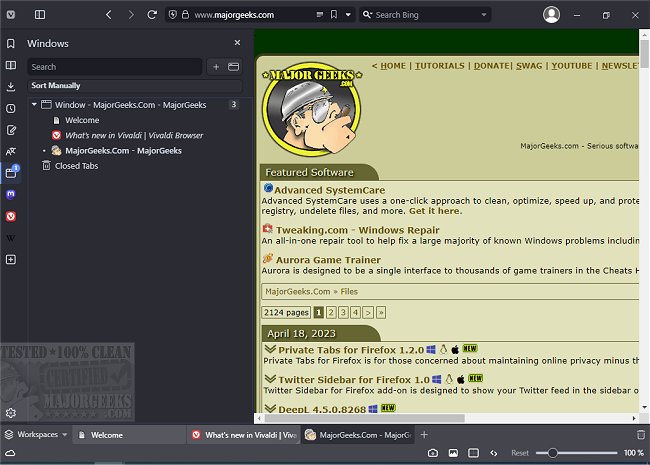Vivaldi has released version 7.4.3684.52 of its free web browser, which was developed by the original creators of the Opera Web Browser established in 1994. This browser is designed for both Windows and Linux operating systems, and users can download the beta version directly from the Vivaldi website.
The Vivaldi browser features an interface reminiscent of Google Chrome, with essential navigation tools like back, forward, refresh, and home buttons conveniently located next to the address bar. Users can easily open new tabs with a simple click on the "+" icon and close them using the "X" tab. The browser includes a sidebar for quick access to bookmarks, downloads, contacts, and notes, while the mail feature is currently not available.
One notable user experience element is the gear icon for options, which some users believe would be better placed at the top right or within the sidebar for easier accessibility. Vivaldi also offers functionality that allows users to control image visibility on web pages, enabling them to display only cached images to enhance browsing speed. Furthermore, users can adjust page rendering significantly, with options for zooming, applying various filters, and modifying fonts, making it an attractive choice for individuals who may struggle with reading content online or simply want to customize their browsing experience for fun.
As Vivaldi enters a competitive browser market filled with loyal users, its unique features and growing capabilities make it a potential contender for increased popularity. While the name "Vivaldi" may not be the most memorable, the browser's offerings suggest a promising future in the digital landscape.
In summary, Vivaldi is carving out a niche for itself among web browsers with its customizable features and user-centric design, and as it continues to evolve, it may very well establish itself as a significant player in the browser market. Users looking for an alternative to mainstream browsers might find Vivaldi's innovative tools and flexibility to be particularly appealing
The Vivaldi browser features an interface reminiscent of Google Chrome, with essential navigation tools like back, forward, refresh, and home buttons conveniently located next to the address bar. Users can easily open new tabs with a simple click on the "+" icon and close them using the "X" tab. The browser includes a sidebar for quick access to bookmarks, downloads, contacts, and notes, while the mail feature is currently not available.
One notable user experience element is the gear icon for options, which some users believe would be better placed at the top right or within the sidebar for easier accessibility. Vivaldi also offers functionality that allows users to control image visibility on web pages, enabling them to display only cached images to enhance browsing speed. Furthermore, users can adjust page rendering significantly, with options for zooming, applying various filters, and modifying fonts, making it an attractive choice for individuals who may struggle with reading content online or simply want to customize their browsing experience for fun.
As Vivaldi enters a competitive browser market filled with loyal users, its unique features and growing capabilities make it a potential contender for increased popularity. While the name "Vivaldi" may not be the most memorable, the browser's offerings suggest a promising future in the digital landscape.
In summary, Vivaldi is carving out a niche for itself among web browsers with its customizable features and user-centric design, and as it continues to evolve, it may very well establish itself as a significant player in the browser market. Users looking for an alternative to mainstream browsers might find Vivaldi's innovative tools and flexibility to be particularly appealing
Vivaldi 7.4.3684.52 released
Vivaldi is a free web browser from the original Opera Web Browser founders in 1994, designed for Windows and Linux. Download the beta version here.


